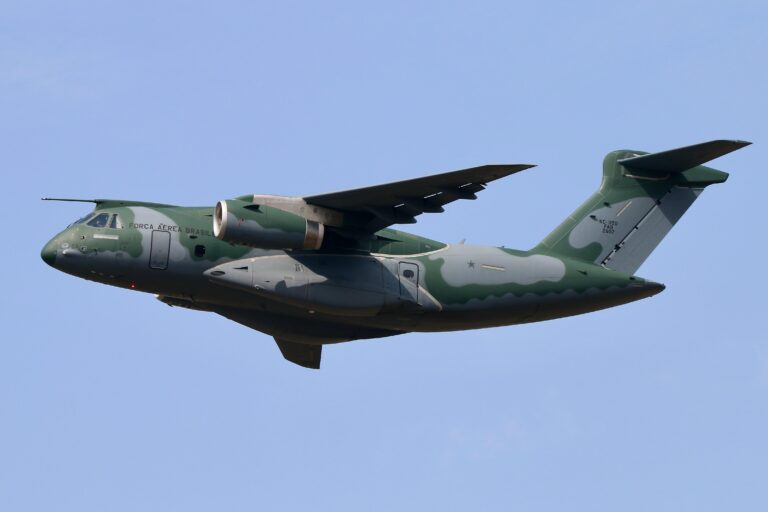The Brazilian Air Force is reportedly considering retiring its KC-390 military transport aircraft following the discovery of significant structural damage sustained during operations in Argentina. According to recent reports from Air Data News, the incident has raised concerns over the fleet’s airworthiness and long-term viability, prompting officials to evaluate alternative options for Brazil’s air mobility needs. This development marks a potential turning point for the ambitious KC-390 program, which was designed to boost the country’s strategic airlift capabilities.
Brazilian Air Force Evaluates Future of KC 390 Fleet Following Structural Damage Incident
The recent incident involving structural damage to one of the Brazilian Air Force’s KC-390 aircraft during operations in Argentina has prompted a rigorous reassessment of the fleet’s future. Initial investigations point to a critical weakness in the airframe’s design, raising concerns about the operational safety and long-term viability of the aircraft. Senior officials are now evaluating whether costly repairs and upgrades are feasible or if retiring the fleet would be a more prudent decision given the potential risks involved.
Key factors influencing the decision include:
- Repair costs: Estimated expenses for structural reinforcements and inspections.
- Operational readiness: Impact on the Air Force’s transport and refueling capabilities.
- Fleet lifespan: Projected service years remaining versus investment required.
- Alternatives assessment: Potential replacement aircraft options and acquisition timelines.
| Aspect | Status | Estimated Impact |
|---|---|---|
| Structural Integrity | Compromised | High risk for continued use |
| Repair Time | 6-9 months | Significant operational downtime |
| Replacement Cost | Undecided | Potentially billions of BRL |
| Fleet Size | Currently 5 active | Could be reduced |
Detailed Assessment Reveals Impact on Operational Readiness and Maintenance Costs
The recent structural damage sustained by the KC-390 during operations in Argentina has triggered extensive evaluations into the aircraft’s operational readiness. Preliminary findings indicate a significant reduction in mission capability rates, prompting concerns about the fleet’s ability to meet ongoing strategic demands. Maintenance crews are now facing unforeseen challenges due to the complexity of repairs required, which are expected to lengthen downtime substantially. The damage has also exposed vulnerabilities in key airframe components, sparking discussions on whether current manufacturing tolerances and inspection protocols need revisiting.
Financial implications are becoming increasingly apparent as maintenance costs are projected to rise sharply. Early estimates suggest that recurring structural issues may lead to:
- Increased frequency of inspections and part replacements
- Higher consumable and labor expenditures for specialized repair procedures
- Potential need for retrofitting or redesign in affected zones
| Aspect | Impact | Estimated Cost Increase |
|---|---|---|
| Airframe Repairs | Extended ground time | +25% |
| Inspection Frequency | Biannual to quarterly | +40% |
| Spare Parts | Higher replacement rate | +30% |
Experts Recommend Comprehensive Review and Enhanced Safety Protocols for Tactical Aircraft
Following the recent incident involving structural damage to a KC-390 aircraft during operations in Argentina, defense analysts and aviation safety experts are urging the Brazilian Air Force to initiate a thorough and transparent evaluation of its tactical fleet. The call for a comprehensive review emphasizes not only identifying the root causes of the damage but also assessing the broader implications on aircraft reliability and mission readiness. Experts stress the importance of incorporating advanced diagnostic technologies and leveraging data analytics to preempt similar failures in the future.
Several key safety measures have been recommended to enhance operational security and prolong aircraft lifespan:
- Routine structural integrity assessments with augmented non-destructive testing
- Implementation of stricter maintenance schedules and real-time monitoring systems
- Re-evaluation of flight protocols under varying environmental and mission conditions
- Enhanced pilot and crew training focused on emergency response and damage mitigation
| Safety Protocol | Focus Area | Expected Impact |
|---|---|---|
| Structural Integrity Audits | Aircraft framework durability | Early detection of fatigue and cracks |
| Maintenance Overhaul | Scheduled upkeep and repairs | Reduced unforeseen breakdowns |
| Flight Operation Review | Mission and environmental adaptability | Optimized safety margins |
| Training Enhancement | Crew readiness and response | Increased survival and damage control |
The Conclusion
As the Brazilian Air Force assesses the extent of the structural damage sustained by the KC-390 during operations in Argentina, the future of the aircraft program hangs in the balance. With significant implications for regional air mobility and defense capabilities, any decision to scrap the KC-390 would mark a pivotal turning point for Brazil’s military aviation strategy. Further updates are expected as investigations continue and official statements emerge.




